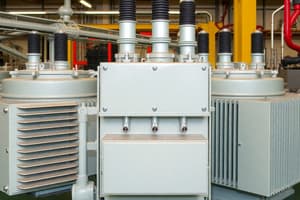Podcast
Questions and Answers
What is magnetic flux?
What is magnetic flux?
The magnetic lines of force produced by a magnet.
Which of the following are types of magnetic materials?
Which of the following are types of magnetic materials?
- Ferromagnetic Materials (correct)
- Paramagnetic Materials (correct)
- Diamagnetic Materials (correct)
- Conductive Materials
What does MMF stand for in magnetic circuits?
What does MMF stand for in magnetic circuits?
Magnetomotive Force
The closed path for magnetic flux is known as a ______.
The closed path for magnetic flux is known as a ______.
Diamagnetic materials are attracted to magnets.
Diamagnetic materials are attracted to magnets.
What is magnetizing field (H)?
What is magnetizing field (H)?
What is the formula for the resultant magnetic field (B)?
What is the formula for the resultant magnetic field (B)?
Define permeability of a magnetic substance.
Define permeability of a magnetic substance.
What is magnetic susceptibility?
What is magnetic susceptibility?
Which of the following materials are examples of ferromagnetic materials?
Which of the following materials are examples of ferromagnetic materials?
In terms of magnetic circuits, what is the analogous term to resistance?
In terms of magnetic circuits, what is the analogous term to resistance?
Flashcards are hidden until you start studying
Study Notes
Transformers
- Transformers are electrical devices that transfer electrical energy between circuits through electromagnetic induction.
- Key components include magnetic materials, BH characteristics, ideal vs. practical transformers, and equivalent circuit analysis.
- Losses in transformers include copper losses, iron losses, and stray losses, affecting efficiency and regulation.
- Auto-transformers utilize a single winding for both primary and secondary circuits, while three-phase transformers can connect in various configurations (e.g., delta or star).
Electrical Machines
- Electrical machines generate rotating magnetic fields which are crucial for operation.
- A three-phase induction motor converts electrical energy into mechanical energy, significant for its torque-slip characteristics.
- Efficiency depends on loss components, including stator and rotor losses.
- Starting methods and speed control for induction motors vary from star-delta starters to variable frequency drives.
- Single-phase induction motors are less common but vital for low-power applications.
- Separately excited DC motors have distinct torque-speed characteristics, essential for varied operational requirements.
- Synchronous generators convert mechanical energy to electrical energy using synchronized rotor rotations with stator magnetic fields.
Magnetic Materials
- Magnetic materials can be magnetized and are classified into paramagnetic, diamagnetic, and ferromagnetic types.
- Magnetic flux (φ) is defined as the total number of magnetic lines of force, measured in Webers (1 wb = 10^8 Maxwells).
Comparison: Magnetic vs. Electric Circuits
- Magnetic circuits have closed paths for magnetic flux; electric circuits have closed paths for electric current.
- Mathematical relationships differ: Flux = MMF / Reluctance in magnetic circuits; Current = EMF / Resistance in electric circuits.
- Common terms include:
- MMF (Magnetomotive Force) for magnetic circuits and EMF for electrical circuits.
- Reluctivity vs. Resistivity, Reluctance vs. Resistance, and Permeance vs. Conductance.
- Flux Density (B) in magnetic circuits and Current Density (J) in electric circuits.
Types of Magnetic Materials
- Paramagnetic Materials: Weakly attracted to magnets with positive relative permeability; examples include aluminium and titanium.
- Diamagnetic Materials: Repelled by magnets, exhibiting less than unity relative permeability; examples include gold and water.
- Ferromagnetic Materials: Strongly attracted to magnetic fields with high relative permeability; examples include iron and cobalt.
Magnetization and Magnetic Fields
- Magnetizing field (H) leads to induced magnetization in materials, measured as Intensity of Magnetization (I).
- The resultant magnetic field (B) inside the material is the combination of the magnetizing field and the magnetic field due to magnetization: B = µ0 (H + I).
Magnetic Susceptibility and Permeability
- Magnetic susceptibility measures how much a material can be magnetized in response to an external magnetic field; proportional to intensity of magnetization.
- Permeability defines a material's ability to support magnetic field formation, indicating the degree of magnetization from an external magnetic field.
Hysteresis Curve
- The hysteresis curve describes the magnetization of ferromagnetic materials in response to varying external magnetic fields, illustrating the lag between applied magnetization and resultant magnetization.
Studying That Suits You
Use AI to generate personalized quizzes and flashcards to suit your learning preferences.




